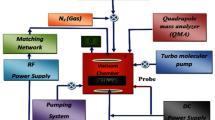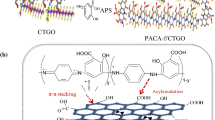Abstract
Known as the super fiber of the twenty-first century, poly-p-phenylenebenzobisoxazole (PBO) fibers exhibit outstanding strength and modulus, fire and heat resistance, which are superior to those of poly-p-phenylene terephthalamide fiber. However, the poor resistance of acid corrosion is regarded as a fatal weakness, which restricts its application in complicated chemical environment. In present work, PBO fibers were exposed in strong acid solutions under different conditions, and then, surface morphology was observed by optical microscopy and scanning electron microscopy. Substantial changes in functional groups were investigated by Fourier-transform infrared (FTIR) spectroscopy, as well as changes in crystalline structure using differential scanning calorimetry (DSC) and thermal stability using thermogravimetric analysis (TGA). After treatment by H2SO4 and HNO3 solution, the strength of the fibers declines typically, while the modulus increases. It is attributed to the formation of N–H bonds in the vicinity of 3410.0 cm−1 confirmed by FTIR spectra. Hydrogen bonds, derived from N–H bonds, increase the thermal degradation temperature from 716.4 °C (untreated) to 725.6 °C (treated by H2SO4), shown in TGA curves. HNO3 treatment is more destructive than that of H2SO4. There exist longitudinal corrosion cracks after treatment by HNO3 solution. Furthermore, HNO3 solution penetrates into crystalline region and destroys the ordered crystal structure of PBO fibers demonstrated by DSC results.









Similar content being viewed by others
References
Hong DW, Cheng Z, Luo LB et al (2018) Effect of surface moisture on direct fluorination of poly(p-phenylene benzobisoxazole) fiber. Polym Mater Eng Sci 34:54–58
Chin J, Forster A, Clerici C et al (2007) Temperature and humidity aging of poly (p-phenylene-2,6-benzobisoxazole) fibers.Chemical and physical characterization. Polym Degrad Stab 92:1234–1246
Tamargo-Martinez K, Villar-Rodil S, Paredes JI et al (2004) Thermal decomposition of poly (p-phenylene benzobisoxazole)fibres: monitoring the chemical and nanostructural changesby Raman spectroscopy and scanning probe microscopy. Polym Degrad Stab 86:263–268
Zhang Z, Wang B, Lv JW et al (2004) Study in progress of interfacially enhancement of PBO/epoxy resin composite. Fiber Reinf Plast Compos 11:104–108
Ma Q, Wang B, Lv JW et al (2017) A facile method modified PBO fibers by polysiloxane microtube. Mater Lett 202:52–54
Chen L, Hu Z, Zhao F et al (2013) Enhanced interfacial properties of PBO fiber via electroless nickel plating. Surf Coat Technol 235:669–675
Liu D, Chen P, Chen MX et al (2012) Surface modification of high performance PBO fibers using radio frequency argon plasma. Surf Coat Technol 206:3534–3541
Zhang RY, Pan XL, Jiang MW et al (2012) Influence of atmospheric pressure plasma treatment on surface properties of PBO fiber. Appl Surf Sci 261:147–154
Zhang CS, Chen P, Sun BL et al (2008) Surface analysis of oxygen plasma treated poly(p-phenylene benzobisoxazole) fibers. Appl Surf Sci 254:5776–5780
Guo F, Zhang ZZ, Zhang HJ et al (2009) Effect of air plasma treatment on mechanical and tribological properties of PBO fabric composites. Compos Part A 40:1305–1310
Zhu P, Liu B, Bao LM (2018) Evaporation-induced surface coating of poly(p-phenylene benzobisoxazole) fibers with polyetherimide encapsulated nano-TiO2. Prog Org Coat 116:43–50
Chen L, Wei F, Liu L et al (2015) Grafting of silane and graphene oxide onto PBO fibers: multifunctional interphase for fiber/polymer matrix composites with simultaneously improved interfacial and atomic oxygen resistant properties. Compos Sci Technol 106:32–38
Li YW, Zhao F, Song YJ et al (2013) nterfacial microstructure and properties of poly (phenylene benzobisoxazole)fiber grafted with graphene oxide via solvothermal method. Appl Surf Sci 266:306–312
Chen L, Du YZ, Huang YD et al (2016) Hierarchical poly(p-phenylene benzobisoxazole)/graphene oxide reinforcement with multifunctional and biomimic middle layer. Compos Part A 88:123–130
Luo LB, Hong DW, Zhang LJ et al (2018) Surface modification of PBO fibers by direct fluorination and corresponding chemical reaction mechanism. Compos Sci Technol 165:106–114
Wu GM, Shyng YT (2004) Surface modification and interfacial adhesion of rigid rod PBO fibre by methanesulfonic acid treatment. Compos Part A 35:1291–1300
Liu SR, Tan YJ, Huo Q et al (2017) Research on ageing mechanism and properties of PBO fiber irradiated by UVB. Text Dye Finish J 39:14–19
Yao M (2015) Science of textile material, 4th edn. China textile press, Beijing, pp 154–155
Acknowledgements
The authors gratefully acknowledge the financial support of Zibo City-Shandong University of Technology Cooperative Projects (2018ZBXC474, Key Research and Development Program of Shandong Province (Soft Science) (2019RKB01208), Innovation Guidance Fund of Yellow River Delta Research Institute (2018-7), the Open Project Program of Fujian Key Laboratory of Novel Functional Textile Fibers and Material, Minjiang University, China (N0.FKLTFM1820), Key Laboratory of Clean Dyeing and Finishing Technology of Zhejiang Province (1804), the Open Project Program of Fujian Key Laboratory of Novel Functional Textile Fibers and Materials (Minjiang University), China (No. FKLTFM1820), Science and Technology Guidance Project of China National Textile and Apparel Council (2018005), Open Fund of Provincial Key Laboratory of Eco-Industrial Green Technology, Wuyi University (WYKF2019-5), Key Topics of Art Science in Shandong Province(ZH201906014), Fujian Provincial Key Laboratory of Textiles Inspection Technology (Fujian Fiber Inspection Bureau) (2018-MXJ-02), Zhejiang Provincial Top Key Academic Discipline of Chemical Engineering and Technology, Zhejiang Sci-Tech University (YR2017006) and Shandong Province Higher Educational Science and Technology Program (J17KB011).
Author information
Authors and Affiliations
Corresponding author
Additional information
Publisher's Note
Springer Nature remains neutral with regard to jurisdictional claims in published maps and institutional affiliations.
Rights and permissions
About this article
Cite this article
Jiang, Z., Tian, M., Guo, Z. et al. Corrosion degradation behavior of PBO fibers under strong inorganic acid. Polym. Bull. 78, 4947–4958 (2021). https://doi.org/10.1007/s00289-020-03348-4
Received:
Revised:
Accepted:
Published:
Issue Date:
DOI: https://doi.org/10.1007/s00289-020-03348-4




